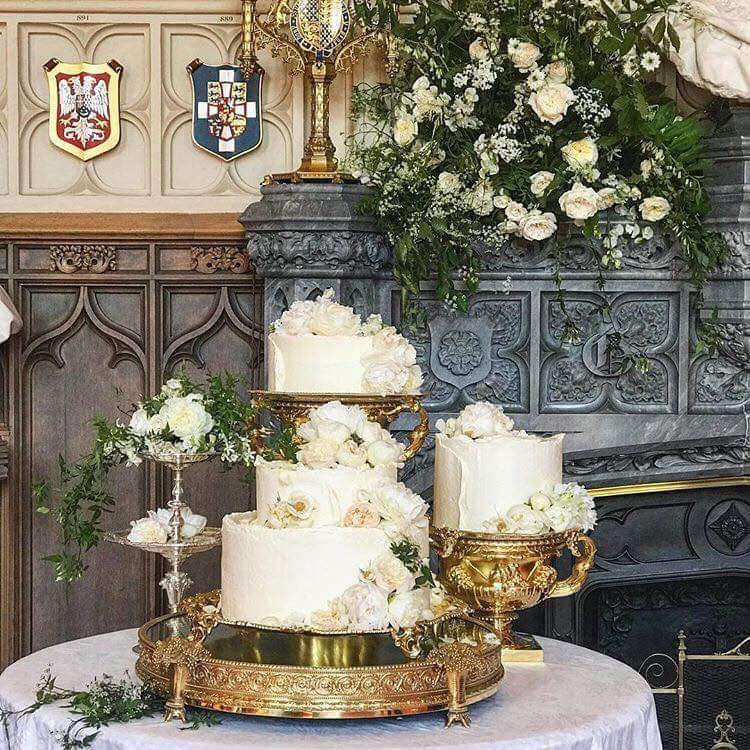|
Last week, equal pounds of butter, sugar, and flour gathered together in a royal kitchen with 500 organic eggs and 200 Amalfi lemons. Six gifted bakers and five days later, an elegant yet rustic wedding cake was unveiled at the wedding of Meghan Markle and Prince Harry.
Collaborating with pastry chef Claire Ptak of London’s Violet Bakery, the young royals envisioned a contemporary cake focusing on seasonal, organic ingredients. Ptak was ideally suited for what might be considered the greatest of British Bake-offs, having honed her skills at the iconic Alice Waters restaurant, Chez Panisse. The finished cake was a far cry from traditional royal wedding desserts, with nary a raisin nor a currant in the mix. For generations, traditional British wedding cakes have been constructed of dowdy, weighty, fruitcake. This had less to do with a penchant for cakes studded with dried fruits and liberally doused in spirits, and more to do with cake stability, shelf life, and a lack of refrigeration. Dating back to the Middle Ages, fruitcake took center stage at weddings (and christenings) because the combination of fruit and alcohol worked to preserve the cake and enhance the flavor. Fruitcake was considered a sensible offering, lending itself to components such as marzipan, cavity inducing royal icing, and the malleable sugar paste known as fondant. Fruitcake laughed in the face of stifling heat and frigid temps, allowing bakers the freedom to add finishing touches to a cake over a period of weeks, sometimes even months. Prince Harry can credit his great-great-great-great-grandmother, Victoria, for being a wedding cake trendsetter. Assuming the role of queen at age 18, two years later, in 1840, Victoria married Prince Albert. At the wedding, Victoria nibbled on a slice of cake cut from a single layer, 14-inch, 300 pound fruit cake. Adorned with edible sugar sculptures, the plum cake was decorated with orange blossoms and myrtle sprigs. Victoria and Albert’s wedding launched a white wedding cake craze amongst royals and commoners. The innovation of icing afforded bakers the chance to cover cakes completely in white. Monochromatic wedding cakes symbolized luxury, but at the same time gave a nod to purity. Despite the fact that a pristine white cake was prohibitively expensive, Victoria’s cake helped to create what some Brits dubbed a “nation of spectators.” Much of British society read detailed accounts of the cake in newspapers, poring over elaborate illustrations. This practice of vicarious royal wedding cake consumption continues today. However, for most of us attending weddings in the states, actual fruitcake consumption remains at an all time low. Oversized tiers of dense fruitcake were precarious to stack and unwieldy to slice. It is doubtful that any royal newlyweds registered for a sterling silver cake knife, instead turning to the family sword for the ceremonial cake ‘sabering.’ In 1947, Princess Elizabeth II and Prince Philip sliced into a 9- foot wedding cake, using the Prince’s ‘Mountbatten’ sword to cut tidy slices for the guests. I imagine a team of butlers standing by with sterling trays of monogrammed napkins, Band-aids and gauze strips. At the time of Elizabeth and Philip’s wedding, post-war rationing restricted the availability of certain ingredients. This included white refined sugar, which was prohibitively expensive. Fortunately, the royal bakers were able to round out their mise en place with critical ingredients provided by the Australian Girl Guides Association. The newlyweds expressed their gratitude by shipping one tier of the completed cake back to Australia. The entire process gives a whole new meaning to borrowing a cup of sugar from your neighbor. Royal pastry chefs continued to embrace white sugar with abandon, taking inspiration from popular architectural styles. Cakes were overly ornate, weighted down with elaborate filigrees, monograms, family crests, dogs, doves, and cupids. Perhaps history’s wedding cake overkill prompted the next generation of royals to rethink the dessert course. Charles and Diana opted for five tiers of fruitcake but chose cream cheese frosting when they married in 1981. They also offered a simple dessert of English strawberries and clotted cream in case anyone needed a cholesterol boost. Sarah Ferguson and Prince Andrew celebrated their wedding in 1986 with a 5½-foot-tall marzipan and rum-soaked wedding cake. Sadly for Fergie and Andrew, marzipan and rum would prove to be the least of their unraveling. At the 2011 wedding of Prince William and Catherine Middleton, a multi-tiered fruitcake was served in addition to a Groom’s cake composed of chocolate, nuts, and rich tea biscuits. Inching further away from tradition, Prince Harry and Meghan’s cake captured the essence of spring, embracing elderflowers and Amalfi lemons, leaving the fruitcake at the alter. Unlike most bakers, Pastry chef Ptak had easy access to the elusive elderflower. The Queen’s Sandringham property boasts a number of elderflower trees, helping to facilitate the ten bottles of cordial needed to douse the cake layers. After a generous drizzle of Elderflower, Ptak layered the lemon sponge cake with tart lemon curd. The cake was then covered in casual swirls of Swiss meringue buttercream before being garnished with three kinds of fresh peonies and roses. Ptak’s finished product was equal part cake plus art installation; the tiers dramatically displayed on gilt gold stands lent to Ms. Ptak by the royal family. The deconstructed four-tier cake capably fed the intimate crowd of 600 guests at the lunchtime reception held in Windsor Castle’s St. George’s Hall. For those of us whose invitation was lost in the mail, or anyone who didn’t get a slice of wedding cake, the pairing of elderflower and lemon is running rampant through bakeries and wedding receptions on both sides of the pond. If you don’t have access to your own elderflower trees, the least you can do is snag a few Amalfi lemons and practice your royal wave.
0 Comments
Leave a Reply. |
Archives
July 2024
Ellen GrayProfessional Pie-isms & Seasonal Sarcasm Categories |

 RSS Feed
RSS Feed